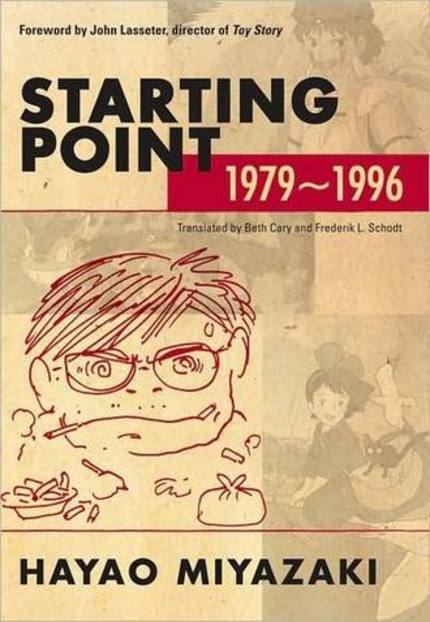STARTING POINT: 1979 - 1996 Book Review

It's hardly a secret that we hold Hayao Miyazaki in very high regard here at ScreenAnarchy. For evidence you need look no further than the recent Mega-ToM where "My Neighbor Totoro" was mentioned most often in the lists of best movies ever made.
But Miyazaki-San is also known for being very outspoken. A famous example of this was his infamous column written in 1989 when Osamu Tezuka had passed away, in which Miyazaki-San was the only person in Japan publicly daring to criticize the man who had been nicknamed "God of Animation".
In 1996 this column was re-published in Japan as part of a hardcover book, which also contained a selection of letters from, interviews with, sketches by, and musings of Hayao Miyazaki.
And in August of this year (after a few delays) publisher Viz released an English translation of that book, called: "Starting Point: 1979 - 1996".
The book covers a very interesting stretch of time in Mr. Miyazaki's life, as in 1979 he had just released two of his first fullblown masterpieces: the television series "Future Boy Conan" and the film "The Castle of Cagliostro".
But then his output became difficult to pinpoint for several years, as he was helping people left and right with other projects, or doing pre-production on movies which never came to be (like the stunning test-clip of the cancelled "Little Nemo").
He also tentatively returned to his old dream of drawing manga comics. Well, that resulted in "Nausicaä" the manga, and later (1984) in "Nausicaä" the movie. This in turn led to the founding of Studio Ghibli (together with Isao Takahata) and his further collaboration with Joe Hisaishi for all of his movie's soundtracks. The rest, as they say, is history.
The period of time covered in the book ends in 1996 when Studio Ghibli is post-producing "Princess Mononoke" and expectations are (rightfully) high for the future.
Don't expect a clear-cut A to B story though: "Starting Point" is not about chronologically telling what Miyazaki-San did between 1979 and 1996. Instead, the book is split in subjects, and on each subject you get a number of things written by Hayao Miyazaki, voicing his opinions.
These subjects are:
- - Creating Animation
- - Periphery of animation (stuff Hayao Miyazaki likes, like nature)
- - People
- - Musings on Film
- - His Own Works
It's funny to read too: for starters Miyazaki-San is a very good writer who has no trouble pinpointing what he wants to tell, often with brutal honesty. But it's also telling that the things he worries about have only gotten worse in the twenty or thirty years since he's been writing about them. Licensing deals with toy manufacturers? Over-abundance of television series? Information overload on behalf of the viewer? Style over content? Empty titillation and violence for the hell of it?
Sure, these may have been issues as well back in the eighties, but several decades of telling about it and giving the good example sure haven't changed much!
As for talking about his own work: near the end of "Starting Point" is a series of interviews done for books about each of Hayao Miyazaki's later movies (starting with "Nausicaä"), and these are stellar. The one which focuses on "My Neighbor Totoro" lasts a whopping 28 pages, and any questions you might have about that film will surely have been answered by the end.
A nice surprise is a small section in the middle of the book which consists purely of drawings by Hayao Miyazaki, and even a 8-page colored comic about dining on airplanes.
In short there is much here to muse over for fans of the man. It gives an extensive look at his worldview and how he incorporates it in his work. But there are omissions too: completely absent is the constant bantering (often turning into straight bashing) between Hayao Miyazaki and Mamoru Oshii, and this is a shame as reading about those two going head-to-head is always brilliant fun. Instead, Mamoru is only mentioned a few times as a friend Hayao uses to bounce ideas against, a bit odd considering the two share a decades long friendly (but VERY competitive) relationship.
There is also quite some repeating going on in the book, although maybe that can't be helped because of the format. Want to know why Isao Takahata is always referred to as Paku-San? You'll get that story, twice.
But all-in-all this book gives a unique insight into Hayao Miyazaki, especially for an audience which cannot speak or read Japanese. Footnotes clarify what the writer is talking about whenever an article dives into details on Japanese history, or local celebrities, or technical jargon about animation. If you're interested in Hayao Miyazaki these 460 pages are definitely a treasure-trove, and this book comes very much recommended.







